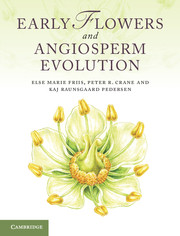Book contents
- Frontmatter
- Contents
- Preface
- 1 Introduction to angiosperms
- 2 The nature of the angiosperm fossil record
- 3 The environmental context of early angiosperm evolution
- 4 Stratigraphic framework and key areas for Cretaceous angiosperms
- 5 Angiosperms in context: extant and fossil seed plants
- 6 Origin and age of angiosperms
- 7 Phylogenetic framework and the assignment of fossils to extant groups
- 8 Fossils near the base of the angiosperm tree
- 9 Early fossil angiosperms of uncertain relationships
- 10 Early fossils of eumagnoliids
- 11 Fossils of monocots
- 12 Fossils of eudicots: early-diverging groups
- 13 Fossils of core eudicots: basal lineages
- 14 Fossils of core eudicots: rosids
- 15 Early fossils of eudicots: asterids
- 16 Patterns of structural diversification in angiosperm reproductive organs
- 17 History and evolution of pollination in angiosperms
- 18 History and evolution of dispersal in angiosperms
- 19 Vegetational context of early angiosperm diversification
- 20 The accumulation of angiosperm diversity
- References
- Index
13 - Fossils of core eudicots: basal lineages
Published online by Cambridge University Press: 07 September 2011
- Frontmatter
- Contents
- Preface
- 1 Introduction to angiosperms
- 2 The nature of the angiosperm fossil record
- 3 The environmental context of early angiosperm evolution
- 4 Stratigraphic framework and key areas for Cretaceous angiosperms
- 5 Angiosperms in context: extant and fossil seed plants
- 6 Origin and age of angiosperms
- 7 Phylogenetic framework and the assignment of fossils to extant groups
- 8 Fossils near the base of the angiosperm tree
- 9 Early fossil angiosperms of uncertain relationships
- 10 Early fossils of eumagnoliids
- 11 Fossils of monocots
- 12 Fossils of eudicots: early-diverging groups
- 13 Fossils of core eudicots: basal lineages
- 14 Fossils of core eudicots: rosids
- 15 Early fossils of eudicots: asterids
- 16 Patterns of structural diversification in angiosperm reproductive organs
- 17 History and evolution of pollination in angiosperms
- 18 History and evolution of dispersal in angiosperms
- 19 Vegetational context of early angiosperm diversification
- 20 The accumulation of angiosperm diversity
- References
- Index
Summary
Core eudicots include the bulk of extant angiosperm species diversity (Magallón et al., 1999) and can be divided into two large clades (rosids, asterids) together with a small number of lineages of uncertain phylogenetic position (Figure 13.1). In this chapter we deal with those lineages of core eudicots that fall outside the species-rich rosids and asterids, but that potentially occupy an important position in the early evolution of the group.
Classification of core eudicots
A four-gene phylogenetic analysis places Gunnerales (Gunneraceae and Myrothamnaceae) as the sister group to all other core eudicots (Soltis et al., 2003). In the APGII classification (2003) the precise position of such lineages as Berberidopsidales, Saxifragales, Santalales and Caryophyllales–Dilleniaceae was not yet securely determined, but in the latest APG classification (APGIII, 2009) the positions of some of those taxa have been clarified. Berberidopsidales, Santalales and Caryophyllales are resolved as a grade of successive sister lineages to the asterid clade, while the Saxifragales are placed as sister to the rosid clade. In this chapter we describe the fossil record of these lineages of core eudicots that appear to have diverged before the diversification of both rosids and asterids. Some of these lineages, such as the Saxifragales, have a well-documented fossil history extending back to the Late Cretaceous.
- Type
- Chapter
- Information
- Early Flowers and Angiosperm Evolution , pp. 311 - 326Publisher: Cambridge University PressPrint publication year: 2011



